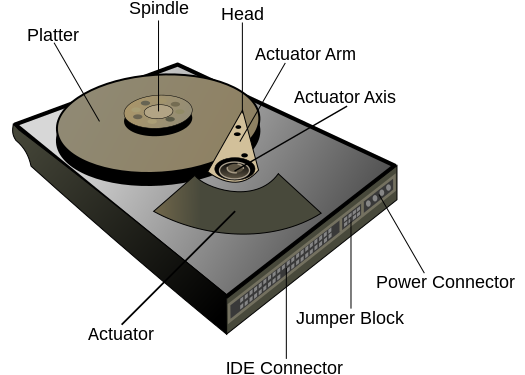
Remember when your computer was new, and running software related to your productivity was no problem? Me neither, it was a long time ago!
As much as I’d love to drop two grand on a new gaming rig, that doesn’t seem extremely practical considering the bad economy and that half of our household’s potential income currently in grad school. Besides, access to the newest games might not be that conductive to productivity, regardless of how quickly my computer would be able to browse the web, open office 2010 documents, or run flash-based applications.
Luckily, there’s a way to upgrade your productive performance without going all the way for a new gaming-ready machine: all you need is an SSD for your operating system and favorite productivity software. The upside is that you can also get this speed boost for less than a tenth of what a brand new desktop might cost.
Table of Contents
HDD vs SSD
Traditional hard disk drives look something like the image below. The information is stored on a platter, and as the spindle spins the platter around to the right location, the head can read and write to the actual disk.

Getting more speed out of a traditional hard drive means spinning the platter faster, but the faster you go, the more you increase the odds of catastrophic failure. There’s also the problem that as the hard drives get bigger and bigger, it can take longer to get through the platter at the same rate of spin.
How is a solid state drive (SSD) different? Well, first of all, there are no moving parts inside. Circuitry holds all of the data persistently, so your data writing and retrieval tasks won’t have to wait on a platter to spin around to and find the right spot.
You’re paying a lot more per GB of storage, but the performance difference is worth every penny. Suddenly, a lot of those tasks that you thought were limited by your CPU or RAM will be loading up in moments. Remember waiting for your computer to boot? Remember even after you got in to Windows, how you’d have to wait another three or four minutes before everything actually loaded up and let you start actually doing things? I do, but only vaguely, and that awful memory is fading faster than this SSD can read a large database.
Installing your SSD
The physical installation is actually pretty straightforward. Like the HDD, there’s an IDE connector and a power connector. These plug in just like they would for any hard drive. Some SSDs are a good bit smaller than HDDs, so if you get a 2.5 inch SSD you will also need to be sure that you have an adapter to secure it in the 3.5 inch drive bays most computer cases have. As long as you’ve got the adapter, and many drives even come with them, this amounts to a few extra screws.
The part that can be kind of tricky and time-consuming is re-installing your operating system and favorite programs. Make sure you’ve got a copy of Windows ready on bootable media, and don’t jump the gun when it comes to formatting your old drives! Remember though, if you want to make the most out of your SSD’s performance potential, you will need to make sure that all of your primary work and operating system software is installed on that drive. Just be careful budgeting your space, and make sure to leave a little bit of room for that super-fast SSD pagefile.
Brands and SSD choices
My SSD is an Intel 520 series, referred to commonly as the Cherryville. This particular SSD is fast, even when compared to other SSDs, and Intel has established quite a reputation for reliable and high-quality products in this niche. Well, every niche really.
OCZ offers some extremely fast SSDs as well, and depending on where & when you buy it, you might be able to get it a bit cheaper than the latest from the Intel line.
The real reason I got the Cherryville SSD is because it was in stock locally, at a great price. Believe it or not, Best Buy was actually selling the 180 GB Intel 520 for about $40 to $50 less than Newegg and TigerDirect. And that’s before shipping costs or having to wait around for delivery! I know, I was shocked to find a good deal at Best Buy as well, but not too shocked to take advantage of it.
The Future of Hosting Computers
I was going to talk about the fact that some hosting providers are now offering SSD-based VPS and cloud storage solutions, but it isn’t shocking that web hosts would take advantage of a new technology that drastically improves computing speeds. So this trend won’t be limited to web-based storage, it won’t be limited to desktops, and it certainly won’t be a passing fad.
If your computer is slower than it used to be – and we both know it is – quit making excuses and get yourself an SSD. I certainly wish I had done it a lot sooner!

Leave a Reply